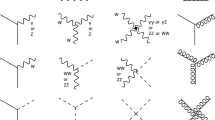Summary
Local duality in the presence of exotic channels implies infinite superconvergence. It is shown in this article that when the exotic channel is formed from a pair of (conserved) currents ofSU 2 ×SU 2 it follows that the use of local duality is a viable approximation to the physics of mesons, and in general is much less good for baryons. The meson spectrum falls necessarily on linear parallel trajectories of fixed quantized intercepts. These latter yield masses for the non-strange mesons in astonishing agreement with experiment (a few percent). With extended assumptions, Veneziano forms for amplitudes emerge and for ππ scattering our assumptions yield the Lovelace-Veneziano formula with no satellites. When the exotic channel is coupled to the unconserved currents ofSU 3 ×SU 3, local duality is generally internally inconsistent with brokenSU 3 (unlike for the coupling to the currents ofSU 2 ×SU 2) but can be reinstated in the presence ofSU 3 symmetry (π, η,K degeneracy). For the exotic channel not coupled to currents at all, evenSU 3 symmetry is no guarantee of local duality; all trajectories (ρ, π ...) must then be collapsed into one to get internal consistency. The natural suggestion then is that local duality is strongly associated with current conservation. The guiding notion is that the set of one-body meson states forms representations and coupling of these one-body states to the many-body cuts may be neglected in a consistent scheme in the presence of conserved currents.
Riassunto
La dualità locale in presenza di canali esotici implica la superconvergenza infinita. Si dimostra in questo articolo che quando il canale esotico è formato da una coppia di correnti (conservate) diSU 2 ×SU 2 segue che l’uso della dualità locale è un’approssimazione ammissibile nella fisica dei mesoni, mentre in generale è molto meno buona per i barioni. Lo spettro dei mesoni cade necessariamente su traiettorie lineari parallele con intercette quantizzate fissate. Queste ultime danno masse dei mesoni non strani in impressionante accordo con gli esperimenti (entro pochi per cento). Con ipotesi estese, emergono le forme di Veneziano delle ampiezze e per lo scattering ππ le nostre ipotesi danno la formula di Lovelace-Veneziano senza satelliti. Quando il canale esotico è accoppiato alle correnti non conservate diSU 3 ×SU 3, la dualità locale è generalmente internamente incompatibile con laSU 3 rotta (diversamente dall’accoppiamento alle correnti diSU 2 ×SU 2) ma può essere ripristinata in presenza della simmetriaSU 3 (degenerazione di π, η, K). Per il canale esotico non accoppiato ad alcuna corrente, anche la simmetriaSU 3 non garantisce la dualità locale; tutte le traiettorie (ρ, π, ...) devono essere allora riunite in una per ottenere la compatibilità interna. Allora la supposizione che sorge spontanea è che la dualità locale sia fortemente associata con la conservazione della corrente. La nozione guida è che il gruppo di stati mesonici ad un corpo formano le rappresentazioni e che l’accoppiamento di questi stati ai tagli di molti corpi può essere trascurato in uno schema consistente in presenza di correnti conservate.
Similar content being viewed by others
References
R. Brout, F. Englert andC. Truffin:Phys. Lett.,29B, 590 (1969).
F. Englert, R. Brout andC. Truffin:Phys. Lett.,29B, 686 (1969).
F. Englert, R. Brout andH. Stern:Nuovo Cimento,66A, 845 (1970).
G. Veneziano:Nuovo Cimento,57A, 190 (1968).
C. Lovelace:Phys. Lett.,28A, 265 (1968).
S. L. Adler:Phys. Rev.,137, B, 1022 (1965).
S. Fubini andG. Furlan:Physics,1, 229 (1965).
M. Gell-Mann:Proceedings of the 1966 International School «E. Majorana», (Erice, 1966), p. 173.
Particle Data Group:Rev. Mod. Phys.,42, 87 (1970).
M. Jacob:Proceedings of the VIII Internationale Universitätswochen für Kernphysik (Schladming 1969), p. 266.
H. Harari:Rapporteur’s talk, Proceedings of the XIV International Conference on High-Energy Physics (Vienna, 1968), p. 202.
F. Englert andR. Brout:Nuovo Cimento,55 A, 543 (1968).
M. Gell-Mann:Phys. Rev.,125, 1067 (1962);S. Okubo:Progr. Theor. Phys.,27, 949 (1962).
S. Fubini, G. Furlan andC. Rosetti:Nuovo Cimento,40 A, 1171 (1965).
Chang Hong-Mo andTsou Sheung-Tsun:Phys. Lett.,28 B, 485 (1969);K. Bardakçi andH. Ruegg:Phys. Lett.,28 B, 342 (1969);C. J. Goebel andB. Sakita:Phys. Rev. Lett.,22, 257 (1969).
Author information
Authors and Affiliations
Additional information
To speed up publication, the authors of this paper have agreed to not receive the proofs for correction.
Aspirant F.N.R.S.
This research has been sponsored in part by «Les Instituts Internationaux de Physique et Chimie fondés par E. Slovay».
Rights and permissions
About this article
Cite this article
Truffin, C., Brout, R. & Englert, F. Local duality and conserved currents. Nuov Cim A 2, 169–196 (1971). https://doi.org/10.1007/BF02723995
Received:
Published:
Issue Date:
DOI: https://doi.org/10.1007/BF02723995




